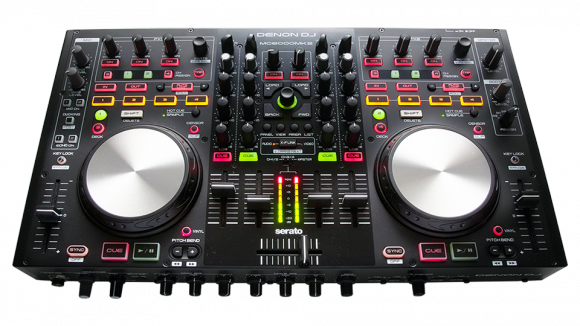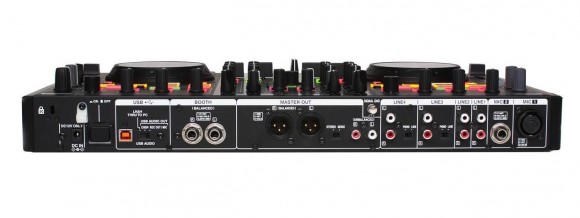The Lowdown
The original Denon DN-MC6000 controller won a lot of fans among working DJs and the MK2 brings lots of smaller changes. The biggest one is that the MC6000MK2 works with Serato DJ software. It’s a pretty much perfect all-rounder controller for that software. Aimed more at the working / mobile DJ than the controllerist, it is highly portable, highly versatile and extremely well built. The addition of a standalone four-channel mixer and two decent mic channels will be the clincher for many. A solid, traditional hybrid controller.
Video Review
First Impressions / Setting up

In the box alongside the unit itself are a quickstart guide; a CD with drivers (for PC, for Mac they’re not necessary) plus Serato DJ Intro software; the power block; power cables for EU and US (these vary according to your region, of course); and a USB cable. There are no 19″ rack mount brackets like with the Mk1, though, so if you’re one of the minority of DJs who would look to professionally mount this, you’ll be speaking to Denon about obtaining a set of these.
The unit itself is very similar to the original – same form factor, broadly the same layout, same high quality of construction. Despite being compact, it’s quite heavy, being an all-metal affair save for the sturdy plastic side panels, which are now black rather than silver in colour (conversely, the compact jogwheels are now silver rather than black). The first impression is of a workmanlike, sober, serious piece of kit, designed to last.

It’s a bit cramped, but is more sensibly laid out than the Mk1, with the pitch sliders now moved to bottom left and right respectively, at the edge of the casing and next to their respective jogwheels. The rest of the deck controls are laid out identically on both the left and right decks, which I think makes sense. Losing the booth EQ from the Mk1 isn’t an omission that will trouble most DJs, and again frees up space. As with the Mk1, using the front panel for a dozen or so controls again helps to cram everything in, although these particular controls are susceptible to damage if you don’t pack the unit carefully when moving it around.
Just the most cursory of glances at the faceplate controls and the back panel reveals that the unit is highly configurable as far as inputs and outputs go, with four full analogue channels (two switchable between line and phono), two mic channels with full EQ, and balanced/unbalanced XLR/RCA master outs plus TRS booth outs. There are even switchable USB-out options, something new to the Mk2. It’s the all-rounder DJ’s dream, because one controller will do you for software DJing and any analogue DJing you may want to do, plus of course it handles video and multiple mic duties too (more about that later).
Setting up is a cinch as with all Serato DJ controllers, and if you’re using a Mac, it’s simply a case of installing the software and plugging in (literally – there’s no USB bus power here, so you have to plug in to outlet electricity for it to work). PC users have a driver to install, but it’s standard stuff. One thing to mention here is that the unit comes with Serato DJ Intro, which is the cut-down free version of Serato DJ; even though this nowadays will let you use all four software channels, I can’t imagine many DJs spending the money on a pro controller like this and then sticking with starter software; factor in dropping the $129 extra to upgrade the software to Serato DJ proper when you buy. It’s Serato DJ, not Serato DJ Intro, that we used in preparing this review.
In Use
General feel
The controller feels great to use. Everything is solid and dependable. The controls – while undeniably close together – are not so cramped as to really disrupt your workflowe, and they are definitely an incremental improvement on the Mk1. The unit has a solid feel and sober look which will suit working DJs; no sense of playing with a plastic toy here. Also, little features like the Kensigton lock and cord grip add an extra layer of assurance for the pro DJ that you won’t accientally power off or come back from the toilet to find the music stopped and your controller gone!
Mixer & library controls
The crossfader is reasonably loose, the upfaders have the expected bit of fight in them, and the EQ knobs are the ususal rubberised high quality Denon tackle, with slightly smaller gain controls so you can tell where you are by feel rather than sight if need be. As with the original, one concession to the size of the thing is that the EQs/gains aren’t exactly above the respective upfaders, but it’s not really an issue. There’s hardware crossfader curve and assign (front of the unit), and although there are only a single pair of VU meters, they’re switchable to channels 1/2, 3/4 and master, so proper gain staging across both digital and analogue inputs is simple.
Decks
The jogwheels, while small, are tight in use and high quality, with no wobble at all. As usual, the top controls scratching, the edges nudging, and there’s a dedicated “vinyl” button to switch this behaviour off. As this is a four-deck controller, there are decks 1/3 and 2/4 buttons, switching the colour from green to red to show you the deck you’re using (it was red and blue to match Virtual DJ’s colours on the original, trivia fans!). Pitch bend buttons are prominent for people coming from CDJs, and the cue and play/pause buttons are rubberised and extremely responsive. There is a small “sync” button a bit apart from the main transport controls for each deck, and as mentioned earlier, the new position of the pitch faders makes a lot more sense.

Mic inputs
As this is – as it always was – a controller aimed at the working and particularly the mobile DJ, the mic options remain superlative. Both mics plug in around the back, and there’s an XLR combo and a TRS to choose from. Both have independent levels, and full three-band EQ. What really stands this controller out from the crowd is the “mic echo” for adding a bit of pro-sounding reverb to the mic input (great for guest vocalists, for instance) and the ducking feature, which is like the talkover function on Pioneer club mixers, letting you drop the volume of the music so the mic is easier to hear.
FX, loops & cues
Nothing out of the ordinary here; the FX areas now reflect standard Serato rules, there is manual and auto looping with roll function, and there are four hot cues, switchable to triggering four samples on the SP-6 sampler player. This is pretty basic and worlds behind the touch-sensitive, multi-colour LED-lit performance pads of most other pro Serato controllers nowadays, and refects the relative importance of these functions to the kind of DJ this unit is aimed at. After all, four cues is more than enough for most DJs, and being able to trigger a couple of namedrops with the sampler again is probably the limit to how most mobile / resident DJs would ever want to use such a feature. If you do want slicer and more creative options, you could add an iPad with Serato Remote running on it – it would be a great complement to this controller, actually, for the odd gig where it mattered.
Filters
There are two active deck filter knobs directly above the fully features library browse/track load section right in the middle of the controller. A good thing about these is that they have “on” buttons, which actually would be moe accurately labelled “off” buttons. Curiously unlit, these buttons cut the filter back to zero instantly, which is a useful thing to have for your mixing, but they don’t actually turn the filters “on” – the filters will always kick in when you turn the filter knob whatever. They’re software filters only, by the way, which is a shame as filter are pretty standard on most analogue mixers nowadays and means this unit falls behind some other controllers like the Vestax VCI-400, for instance.

Serato-specific controls
As this is now an official Serato controller, there are a whole host of dedicated Serato controls. Apart from labelled roll & slip functions, there’s censor and all the Serato view preference controls (panel, view, are and list) to help you choose the right waveform/deck layout, library layout (cover view or list) and what extra modules, such as FX, are shown on your screen. As touched on earlier, the FX section now reflects Standard Serato layout, with the fourth knob being the “beats” modulation length control; there’s also a beat tap button for those pesky hard-to-analyse BPMs.
With Serato Video such a big part of Serato’s current offering, and this controller’s lineage as a Virtual DJ unit (Virtual DJ being the first mainstream DJ software to take video seriously, of course), it’s not surprising that Denon has retained the audio/video options for the crossfader, and the selector button now also lets you choose your video transition here too. We didn’t test the video functions, but note that this unit controls, doesn’t output, video; the video outputting comes from your computer.
Conclusion
What Denon has done here is deliver a streamlined, slightly improved take on the original MC6000, with the killer change of now working out of the box with Serato DJ. So whether this is the controller for you or nor really depends on how much you want to use Serato DJ as your software of choice. If you do, and you’re the kind of DJ this is aimed at, it’s a great controller. You’re probably a mobile guy, a working DJ with lots of differing requirements as far as what you’re going to be plugging into your DJ controller (and what you’re going to be plugging it into) – or you may just be someone after a solid, dependable and portable controller that’ll last you a long time.
It’s not for you if you’re into all the latest bells and whistles, and it’s also not for you if you’ve got big, fat, clumsy hands (it is undeniable a busy control surface).Plus, at this price, it would have been preferable to get the full Serato DJ software in the box, because adding the price of that on means the overall cost is not exactly cheap, But basically, if you loved the original but always wished you could use it with Serato – here it is. I see no reason why in that case you shouldn’t just go for it, and also I see no reason why the MC6000 Mk2 can’t find its niche among the raft of new controllers for Serato DJ; for a certain type of DJ, it’s in a class of its own.
Want it? Click here to buy it on Amazon.




